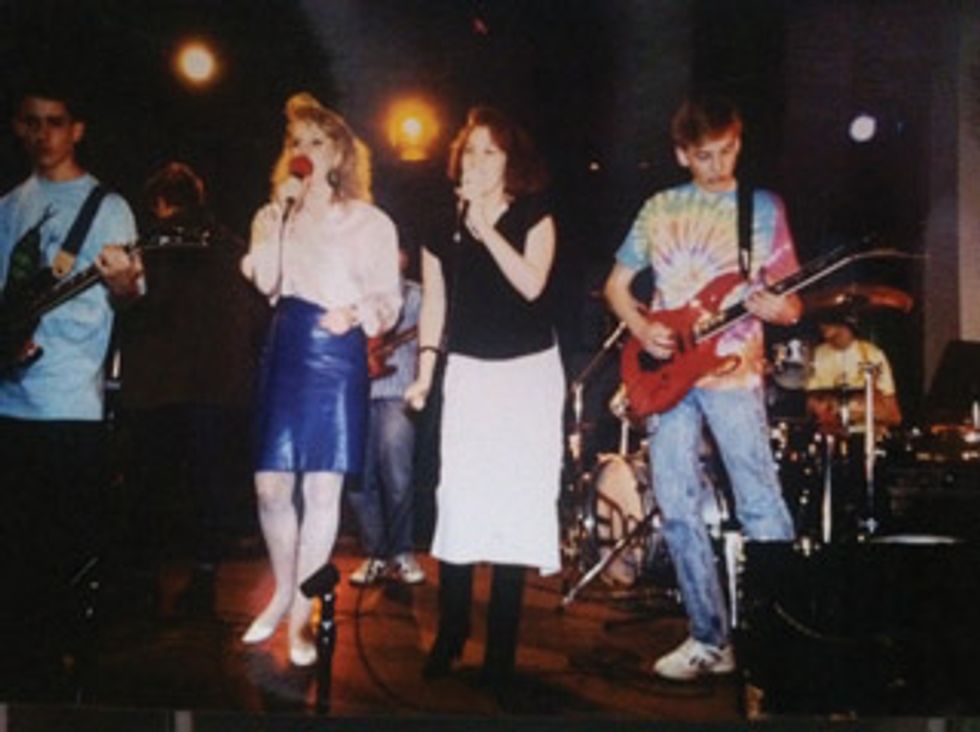Each of us has a pedal history that tells an interesting story about who we are, where we came from, and maybe even where we’re going.

This circa-1987 pic shows me, in the earlier portion of my pedal history, playing with my mostly covers band, the Edge (sorry Mr. The Edge!), at the Backstage Cafe in Provo, Utah. I’m the one with the red guitar plugged into a DigiTech PDS 1550 pedal and DigiTech DSP-128 rack (both not shown) and a Roland JC-120 (far right).
Ahhh … pedals. For anyone acquainted with a guitarist or bassist well enough to have heard the endless tales of overextended credit cards, marital strife, and/or exhaustingly hyperbolic descriptions of sonic glory, no other single word can quite encapsulate the mania, fickleness, obsession, narcissism, instability, adventurousness, or schizophrenia that typifies us.
But when you look beyond the tedious, clichéd yakking about monstrous pedalboards, closets overflowing with stomps, seller’s remorse, and how much better the earlier version of pedal X is than the “pathetic” current model, each of us has a pedal history that tells an interesting story about who we are, where we came from, and maybe even where we’re going.
My own pedal history is pretty unique for a number of reasons. As I’ve shared here before, having taken up electric guitar at the age of 13 in mid-’80s Provo, Utah—not exactly a hotbed of raging guitar awesomeness at the time—I had practically zero guitar-playing peers (other than my instructors) when I started out. Add to that the fact that DOD and DigiTech effects were made less than 40 miles away and that the raddest guitarist in town was a DigiTech clinician whom I idolized, and you get why my first few pedal years were dominated by those brands. I got a DOD FX56 American Metal pedal within a year or so of buying my first Strat, and a year or so after that I got a DigiTech PDS 1550 2-channel distortion and an Ibanez DML digital modulation delay. And then things sort of snowballed. A DOD FX-17 Wah-Volume, a DOD FX35 Octoplus, and a DOD FX10 Bi-Fet Preamp followed over the next year or two.
Toward the end of high school and the beginning of college, I ventured off into broader, more classic-oriented tones with a Hughes & Kettner Tubeman, an Ibanez AD99 analog delay, an MXR Phase 90, a Dunlop Rotovibe, and a Cry Baby 535Q. Full confession: There was a brief period during which I stomped a Zoom 505 multi-effector, but that was only to facilitate late-night headphone jamming as an apartment dweller. Honest.
Around the time I started working as a freelance guitar journalist (roughly 13 years ago), I began to get a taste for boutique brands. After a lot of research, I bought a Demeter Tremulator (which I still own and love), and briefly owned one of the most gorgeous-sounding analog delays on the planet—a Maxon AD999—before letting pedal lust and the Maxon’s high fetching price convince me to sell it and rely on the very good tape-delay emulation in a DigiTech DigiDelay. I continued my phaser flirtation with an Electro-Harmonix Small Stone, and then began to get into more experimental sounds with a 4th-generation DigiTech Whammy.
When I joined a synth- and bass-heavy modern-rock band a while after that, I found that my beloved Fulltone OCD through a silverface Fender didn’t cut through the mix quite as handily as—get this—a $19 Danelectro Bacon ’N Eggs distortion/ mini amp. A while later, my appreciation for J. Mascis and other masters of Neanderthalic amazingness inspired a Z.Vex Fuzz Factory purchase. But not long after that I inexplicably entered my current semi-minimalist, atmospheric-punk-twang phase, which began with being seduced by a Strymon BlueSky Reverberator. A bit into this phase, I realized it was about time I throw a compressor on my ’board, and I bought an MXR Dyna Comp. I mean, c’mon—twang without compression? I didn’t know what I was missing.
A while later, I eased up on my minimalism and got back on the dirtbox wagon with a few different boosts and overdrives, finally settling on a Pigtronix Fat Drive. After digging the comp for a while, my tastes morphed a little and I hankered for the flat, pristine response I heard out of Sonny Landreth’s 2-knob Keeley Compressor and decided I had to have one.
Save for a few leaps over years, stylistic phases, and gear that’s now a little hazy because of the minimal sleep I’ve had over the last few nights leading up to putting this here Pedal Issue to bed, these are the main pedals that come to mind from my stompbox story so far. Due to the sleep deprivation, I’m certain I’ve overlooked a few purchases here and there. And, like all of you, I’ve played countless great boxes that, for one reason or another—often simple lack of funds—didn’t end up on my pedalboard (being a guitar journalist for so long has certainly provided innumerable opportunities to stomp on new tone toys). But these are the main ones that ended up under my toes for a significant period of time.
What do they say about me? I guess that’s open to interpretation, but to me they tell the tale of young, trusting naïveté gradually evolving into a more aware, more discerning adolescence, then a more bourgeoisie adventurousness, and then to a more self-confident willingness to strip things down and reject pomp but not circumstance or craziness. I don’t even know if that makes sense to anyone else—it may just sound like a whole lot of pomp. But whatever … to each their own.
Here’s to your pedal stories! I’d love to hear them.

